| Pakolor - Home Colour Negative Printing |
|
|
|
|
| Manufactured in England by the Photo-Chemical Co Ltd (distributed by Associated British-Pathe Ltd, Pathé House, 133/135 Oxford St, London, W.1) Pakolor colour film and print materials first appeared in the UK around 1952. They were announced to the photographic press in mid-1952 and results from trial rolls of film were reviewed in Amateur Photographer (AP) magazine for July 23rd 1952. This link connects to a web page showing two of the earliest AP adverts for the newly announced Pakolor, by the distributors Associated British-Pathe Ltd (My thanks to Michael Talbert for sending me copies of these advertisements). | ||
| The 1952 AP Review of Pakolor film and its commercially produced prints can be read here. |
|
|
| My
thanks to Paul Godfrey for telling me of information by Jack
Coote, written in his "Illustrated History of Colour Photography".
(Jack Coote was Head of
Technical Services for the Ilford Group during the 1970s and
later became Technical Advisor to the Head of Marketing.) "In 1952 the Photo Chemical Company, operated by Dr. K. Jacobson and Dr. White in the UK, launched the Pakolor negative-positive process in conjunction with Associated British Pathe, the motion-picture production company. Pakolor film, based on Agfa technology, was coated by Standard Photographics of Leamington, while the paper was produced by Kentmere at Staveley in the Lake District. The colour couplers and other special chemicals were supplied by the Photo Chemical Company and the film processing kits incorporated a combined bleach-fix for the first time". |
||
| Paul Godfrey has sent further information, from “The Manual of The Miniature Camera” by T.L.J. Bentley. To read the full extract, click on the link opposite. |
|
|
|
Paul was especially interested to read that "Pakolor" paper was supplied in two types:Type T and Type C, for use with tungsten and cold-cathode illumination respectively. He comments "I have not heard of anybody using cold cathode illumination for colour printing. I had a Lines & Jones ½plate enlarger and have also used DeVere 5x4s, both with cold cathode illumination. The output of these light sources was very blue, good for dust and scratch suppression but needed (for monochrome printing) a grade of paper higher than the same negative printed using a condenser/tungsten type enlarger. Making a colour paper balanced to use cold cathode is really surprising and I do not think any other colour paper manufacturer has ever catered for it". By 1956 Pakolor paper became Type FC (see below). It is possible the 'F' refers to the 'F.R. Process' that was a USA colour processing chemistry based upon the Pakolor process and using Pakolor paper. Although Pakolor negative film was originally only balanced for daylight, by 1953 it was available in two types, daylight and artificial, both of speed 15ASA and both available in roll, cut and 35mm film formats. The 1952 AP review said the film was rated at Weston 12 (around 15ASA) but they found this a bit excesive and suggested Weston 8 for general work (10ASA) "bearing in mind that slightly full exposure is more tolerable than slight under-exposure, and that colour film is too expensive for one to risk failure lightly." The 10ASA speed recommendation seems to have been adopted by Pakolor, as 10ASA is often quoted as the film speed in subsequent references (see the BJPA 1955 test, below). Amateur Photographer credited Pakolor's technical development to Dr.C.I.Jacobson though strictly the originator was Dr.K.I.Jacobsohn, as his name was Kurt Israel Jacobsohn. He came to England, with his wife, from Nazi Germany in 1939. |
||
| Dr.Jacobson (Dr.Jacobsohn) and his Photo-Chemical Co Ltd, were also responsible for originating the Paterson-Pavelle home colour printing process which was marketed in the UK by R.F.Hunter (Paterson distributors) from 1963 and by Johnsons of Hendon from 1967. |
|
|
| In 1952 all Pakolor processing was carried out either by Pakolor or by designated laboratories (see David Goodall's story of his work at the Eucryl Colour Film Laboratories in Southampton). |
|
|
|
In May 1955, Modern Camera Magazine (MCM) carried an announcement that "Mr R M Reed of Associated British-Pathe has prepared a most interesting lecture, fully illustrated with colour slides, on Pakolor home processing and printing, and his lecture is available to accredited clubs and societies on request." |
||
| Pakolor paper was also available for direct reversal printing of colour transparencies, Paper Type DRP. To read more: |
|
|
|
Home
processing Pakolor Films and Paper, from 1954, using the Johnsons
of Hendon kit. Below is shown a Pakolor advertisement from the BJPA for 1956 (p573) and an advertisement from the Amateur Photographer magazine, 8th December 1955. |
|
 |
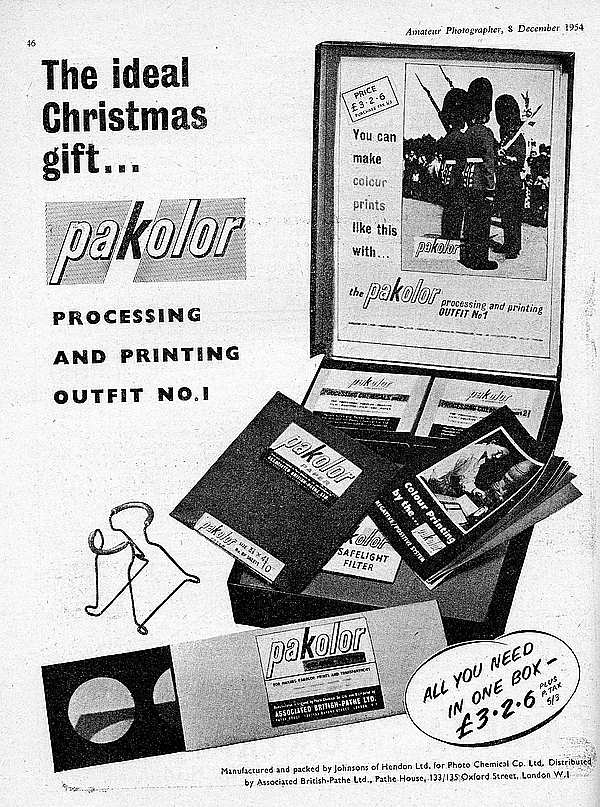 |
| The following notes and processing sequences have been compiled from the BJPAs for 1955 and 1956, plus information and a photograph of the early tri-colour filters, as supplied by Michael Talbert. | ||||||||||||||||||||||||||||||||||||||||||||||
|
Extracted from the
1955 BJPA, pages 260-262) Now the process as a whole is available for operation by the photographer at all stages. As such it will now be of interest to professional photographers and to amateurs who wish to make their own colour prints by a negative-positive process. The processing outfit (which is made by Johnsons of Hendon) consists of three components, the developer, the stop bath, and the bleach-fix. All are supplied as dry chemicals and the developer makes 4 litres, the stop bath 1 litre of stock solution, and the bleach-fix 1 litre of working solution. The developer is made up as three stock solutions, which is always a good system for colour developers, and in this state will keep for several months in well-stoppered bottles. The processing chemicals are used for both film and paper processing, the stop bath and bleach-fix being used interchangeably for both materials. The developer stock solutions are used in different proportions according to whether the working bath is to be used for film or paper. A hardener-stabiliser bath is also used for both the film and the paper and this is not supplied in the kit. However, this is a simple solution consisting of 20c.c. of 40 per cent formaldehyde and 2.5 gm. of anhydrous sodium carbonate per litre. |
||||||||||||||||||||||||||||||||||||||||||||||
|
Film Processing The film is developed in entirely orthodox fashion using either the conventional spiral-groove tanks for roll-film or deep tanks for sheet film. The film-processing schedule is as in the table below. The first four steps were carried out in total darkness, or by the light of a Pakolor paper safelight screen, a deep olive green filter. The process was principally for amateur dish processing. The “Goodman” tank had yet to appear on the market. |
||||||||||||||||||||||||||||||||||||||||||||||
Thus far, it will be seen the process corresponds fairly closely with the handling of black-and-white material and indeed tests show that provided the temperature of the developer is held at 65°F. within the usual ½°F tolerance prescribed for colour film, colour negatives of good gradation and excellent general quality can be obtained with no more difficulty than is normally experienced using black-and-white film. |
||||||||||||||||||||||||||||||||||||||||||||||
|
Printing
and Paper Processing The three exposures are made
through a special set of tricolour filters which can be obtained
as separate gelatin sheets or ready mounted in a filter-disc
assembly which is held on the enlarger lens mount by 3 set-screws. Opposite are the tricolor filters mounted in simple card mounts. These Pakolor additive filters are owned by Michael Talbert. Michael says "The price on the box is 19s/6d (97.5p), comprising 14s/7d + 4s/11d purchase tax. The red filter is very dark, but the later red filter for use with Pakolor Type FC paper (see below), was lighter (ref: Focal Photo Guide No.83; Pakolor, published around 1958). |
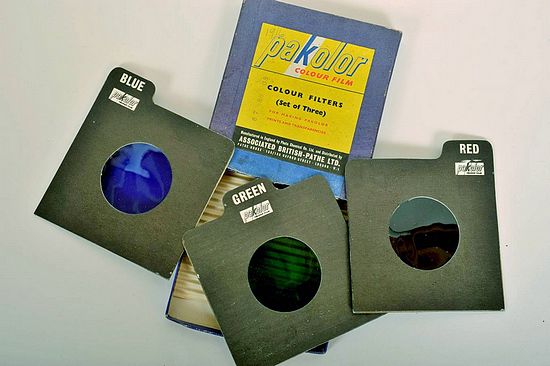 |
|||||||||||||||||||||||||||||||||||||||||||||
|
For handling the paper, which is, in effect, panchromatic in sensitivity, a moderately bright olive-green safelight is supplied. The fact that the three emulsion layers of the paper are separately exposed means that some precautions must be taken to avoid differences of size or position of the three images in printing. It is recommended, for example, that glass carriers should be used in the enlarger since exposures are rather longer than are usual with black-and-white materials and there would be a risk of heat causing the negative to distort and change its position between the exposures. Similarly it is advisable to be sure that the enlarger lens mount, on to which the filter disc is fitted, is reasonably firm. A voltage-control unit is naturally a help in maintaining consistency of colour balance with this process as with any other. The method adopted to expose a test which will provide some indication of the exposures needed through the three filters for a particular negative is a simple modification of the system generally used in black-and-white practice. A small sheet of paper (say about 3x2 ins.) is used and is given a series of increasing exposure times in one direction through the red filter. The filter is then changed to green and a series of exposures again given but in this case the mask is moved at right-angles to the direction used for the red filter exposures. A final over-all exposure is given through the blue filter the amount being some arbitrary time for the first test. |
||||||||||||||||||||||||||||||||||||||||||||||
|
After processing the test will show an equal amount of yellow throughout and rectangles of increasing cyan density across the picture area and increasing magenta in a vertical direction. At least one of these rectangles should show something approaching correct colour balance and will thus give some indication on which a further test can be made. The processsing schedule for paper is shown in the table below. |
||||||||||||||||||||||||||||||||||||||||||||||
Notes by Michael Talbert:
|
||||||||||||||||||||||||||||||||||||||||||||||
|
The 1955 BJPA Review continues: All of these sensitive materials are products of good quality, and when properly used the Pakolor process will give results which compare extremely favourably with any other system of the negative-positive type. Pakolor roll-film in 120 and 620 sizes is priced at 11s.2d. plus 3s.l0d. purchase tax per 8-exposure roll, 35-mm. film is 13s.5d. plus 4s.7d. purchase tax for a 20-exposure cassette, 20-exposure refills are 11s.0d. plus 3s.10d. purchase tax and 25-ft. lengths cost £2 4s.0d. plus 14s.8d. purchase tax. The prices of sheet film range from £1 2s.6d. plus 7s.9d. purchase tax for quarter-plate size to £6 0s.0d. plus £2 1s.0d. purchase tax for 10 x 8 ins. per box of 10 sheets in each case. With the exception of the 2½
x 3½in. size, Pakolor paper is available in either 10-sheet
or 25-sheet packets; the small size is available only in 25-sheet
packets which cost 9s. 9d. plus 3s. 2d. purchase tax. The price
of paper ranges from 6s. 9d. plus 2s. 3d. purchase tax for 10
sheets of quarter-plate size to £1 12s. 6d. plus 10s. 10d.
purchase tax for 10 sheets of 10x8 in. Other sizes between these
limits are in proportion. The processing kit to make the quantities specified earlier costs 35s. 3d. and a 5x7in safelight screen costs 9s.6d. The 10x8in safelight screen costs 12s.3d. A complete Pakolor processing and printing outfit No.1 costs £3 2s.6d. plus 5s.3d. purchase tax. |
||||||||||||||||||||||||||||||||||||||||||||||
| 1956
BJPA (p217) report of the Pakolor Processing and Printing Outfit
No.1 The 1956 BJPA announced that: "One interesting modification is the hardener-stabiliser which was not formerly supplied with the kit but had to be made up by the user from formaldehyde solution. This solution is now supplied as a dry chemical which is dissolved in water in the usual way to make the working bath". |
||||||||||||||||||||||||||||||||||||||||||||||
 |
The 1956 BJPA also compared results from the three colour negative films then available in the UK. "The best resolution is obtainable from the Gevacolor process, and this is also capable of the reproduction of red with an almost dye transfer quality, coupled with a good generall overall fidelity of colour reproduction. Agfacolor material, in the writer's experience, is most consistently reliable, and although the reproduction of red is not as brilliant as with Gevacolor, the quality obtainable using Agfacolor material can be extremely good. Pakolor, as one may perhaps expect of a process comparatively new, tends to suffer rather from inconsistency and emulsion coating faults, although the process does not appear to enjoy the entire monopoly of this type of fault. The fidelity of reproduction can be very good, but with some tendency to exaggeration of certain colours, particularly blue. In the separation of colour it can be superior to either of the other two processes, at some expense of contrast." Left is shown a 10 sheet box of Pakolor 5"x4" daylight balanced cut sheet film, courtesy of Paul Godfrey who has received the box from the break up of the memorabilia collection of Charles Read ARPS, a founder member of Great Yarmouth & District Photographic Society. Sadly, Charles Read died in August 2008. |
|||||||||||||||||||||||||||||||||||||||||||||
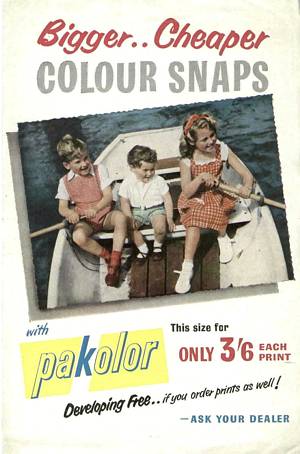 |
 |
|||||||||||||||||||||||||||||||||||||||||||||
|
By 1959 Pakolor materials were distributed by Pakolor Ltd, Epsom, Surrey. The company was advertising "Everything for Colour" via their 'Double U' system "enables the photographer to print and enlarge from all makes of colour negatives by easy stages." "..begin with a simple Colour Processing Kit and add ... according to... requirements." Home printing kits cost FROM £1 13s 5d (£1 67p). The 1959 price of a kit to develop Pakolor Super 40 (ASA) colour negative film was 17s.6d (88p), but presumably it processed several films as commercial film developing only cost 6s.6d (33p). Pakolor Paper Type DRP was also available for direct reversal printing of colour transparencies. The BJPA for 1960 describes it as "a three-layer paper designed to make colour prints directly from colour transparencies". Follow the link here, or the one near the top of this page, to read more about Type DRP and its processing. |
||||||||||||||||||||||||||||||||||||||||||||||
|
Pakolor Paper Type
FC The BJPA for 1960 describes Pakolor Paper Type FC as "a three-layer paper available in two grades, normal and hard, primarily intended for printing from Pakolor colour negatives". The recommended printing technique for Type FC paper remained the three exposure additive printing method, using a set of tri-colour filters. It is likely that this paper would still have been balanced for unmasked colour negatives, as Pakolor negative film was of the unmasked variety, similar to Agfacolor CN17 film. But masked Kodacolor film was being sold in the UK by the end of the 1950s. |
|||||||||||||||||||||||||||||||||||||||||||||||||
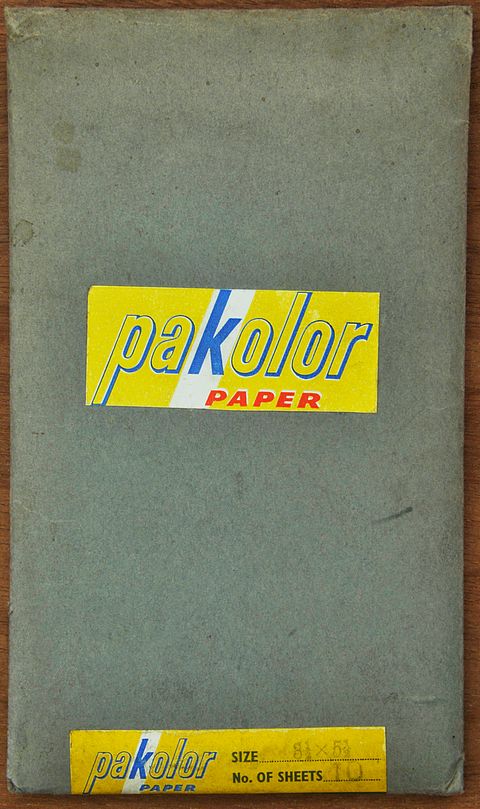 |
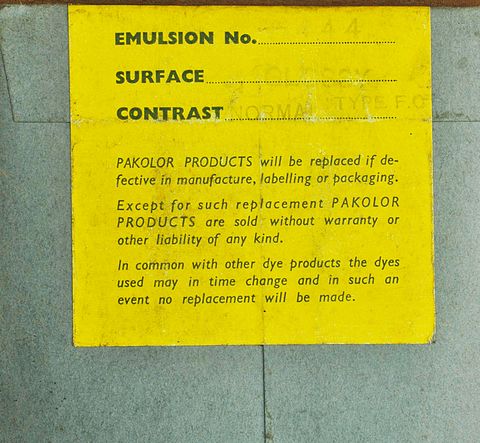 |
||||||||||||||||||||||||||||||||||||||||||||||||
| Pakolor
FC Process In the Type FC process it was possible to replace the Stop Bath with a “Stop-Fix” solution, available in a 1 litre size. The “Stop-Fix” was not included in the Pakolor processing kit and had to be obtained separately. The process schedule is shown in the table below, and is believed to be the last Pakolor colour print process, |
|||||||||||||||||||||||||||||||||||||||||||||||||
Notes.
|
|||||||||||||||||||||||||||||||||||||||||||||||||
 |
Left is the cover of a Pakolor booklet entitled “All about Colour with Pakolor”. A Focal Press booklet on Pakolor film processing and printing onto Pakolor paper by the Tri-Colour (additive) method, written by L.A. Mannheim. This booklet was published in 1960 and two thirds of the booklet is devoted to colour print making using the later type of Pakolor Type FC paper and the Pakolor processing kit, packaged by Johnsons of Hendon.. Sections include: A very informative booklet. Pages 26 and 27 (see image below) show the processing sequence for Pakolor Type FC paper. Mr.Lillington Hall in one off his books published by George Newnes Ltd. Tower House, Southampton Street, London W.C.2, gives ratios of the blue, green and red exposures when using Pakolor Tri-Colour filters.
A Pakolor standard negative was provided with the printing kit. You printed this negative and, having found the tri-colour exposure times to make a good print, these times for the Pakolor standard negative were multiplied by the factors in the table when printing from either Agfacolor, Gevacolor or Kodacolor. Note how an exposure factor of 5 is needed to get enough blue light through Kodacolor's mask, because all three layers of the unmasked paper were approximately the same speed. The other films would have been unmasked. |
||||||||||||||||||||||||||||||||||||||||||||||||
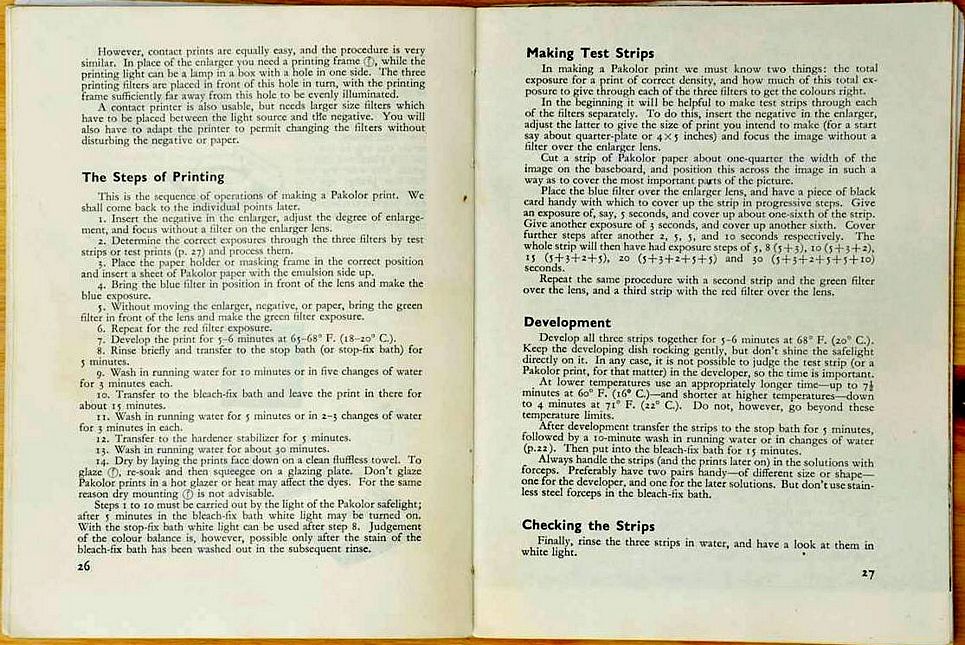 |
|||||||||||||||||||||||||||||||||||||||||||||||||
|
Pakolor after 1960 Alongsidse is a P.S.Color Services advert from an Amateur Photographer magazine dated 1st November 1961. The 40ASA Pakolor print film was included in AP's 'Outdoor Number' on 7th March 1962, with a 620/120 roll film costing 8s.3d (41p). Developing cost 6s.6d (32.5p) and en-prints (2¼"x4½" or to negative shape) cost 2s (10p). Pakolor was also available in a 12 exposure cassette for 8s.3d. Around 1960, and certainly
by 1963, Pakolor colour printing paper was replaced by the US
produced 'Pavelle' colour printing paper and processing chemistry,
formulated using techology know-how that originated with the
Photo Chemical Co. Ltd. To read the next chapter in
this technology and company development, click here: |
 |
||||||||||||||||||||||||||||||||||||||||||||||||
|
|
|
|
|
|